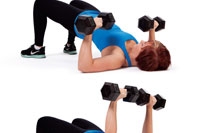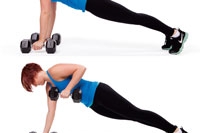
Many women shy away from weight training. Here, we discuss benefits, shatter myths, and provide exercises.
Weight training is the key to success for any woman who wants to tone up, improve bone density, increase metabolism, and stop muscle shrinkage as she ages. All while building the strength to do what she wants, when she wants.
Knit new muscles
When we lift weights (or any heavy object for that matter) that stress the musculoskeletal system, we create tiny microscopic tears in the affected muscle tissue. Our bodies, being the amazing machines they are, sense this trauma and send in a SWAT team to repair those tears.
The SWAT team (which consists of hormones, growth factors, and white blood cells) goes about the task of mending the affected fibres. It realizes the muscle was not strong enough to start with, so it “knits” those tears together to make our muscles stronger and denser than they were before.
Blame it on your genes
Many women shy away from weight training because they fear it will make their muscles big, or they haven’t got the foggiest idea of where to start. Weight training not only builds muscles, it also builds confidence—and confidence is one of the sexiest traits a woman can have.
We do develop bigger, denser muscles when we weight train, but how big our muscles develop really depends on our body type.
You may have heard that it is impossible for women to bulk up (like our male counterparts), because we lack sufficient amounts of the necessary hormone, testosterone. We can still develop muscles, but how large they become depends on our genes.
What’s your body type?
Body types fall into one of three categories. The mesomorph body type tends to be muscular in the first place (think of the actress Angela Bassett). Then there are the endomorphs, who have more curves and tend to be more voluptuous (think Marilyn Monroe), and finally there are the ectomorphs (think Olive Oyl), who tend to be thinner and leaner.
When performing a weight-training program, a mesomorph will build muscle faster than an ectomorph, even if they do the exact same workout. Genetically, the mesomorph is just hard-wired to do so.
Knowing what body type we are helps immensely when choosing the correct path to reach our fitness goals. For example, if you are a mesomorph (who builds muscle easily), and you do not want too much bulk on your frame, then you would choose a lighter dumbbell and keep your repetitions high.
If your body is more the Olive Oyl build (ectomorph), and you want to increase your muscle tone, then you need heavier dumbbells with fewer reps.
How to begin
Starting a weight-training program takes patience. In order to get the most bang for your fitness buck, with the lowest chance of injury, you need to build slowly and train consistently.
A good understanding of form is also important. Find and maintain a neutral spine alignment while lifting and lowering the weights in a slow, controlled manner (see sidebar on page 65 for weight recommendations).
10-Minute Express Home Workout
Warm-up: Make the time to warm up properly by taking a 5-minute brisk walk or jog.
Perform each exercise, one after another, for the recommended number of repetitions. Once you complete the circuit, take a quick water break and then perform it again. Aim for 3 to 6 sets or 10 minutes, whichever comes first.
Bridge with Chest Press (15 reps)

Muscles activated: pecs, triceps, anterior deltoid, hamstrings, glutes, low back
- Lie on your back with knees bent, feet hip-width apart and close to your bum.
- Lift your hips as high as you can and keep them lifted throughout the exercise.
- Position dumbbells in each hand with elbows bent and lined up with your shoulders. Hands are in line with your elbows and your palms are facing away.
- Press the dumbbells up and above your chest and slowly lower back down to start, until the backs of your arms are touching the ground again.
Stationary Lunge with Twist (15 reps each leg)

Muscles activated: quadriceps, hamstrings, glutes, obliques
- Set yourself up in a stationary lunge holding onto each end of one dumbbell.
- The dumbbell is held close to the upper abdomen, and as you lunge down, slowly twist the upper body toward the front leg. Be sure to twist using your waist muscles, not your shoulders.
- While lunging, your front knee should line up with the ankle and the back knee should drop down to the floor as low as you can (ideally just stopping an inch or two above the ground).
- Come back up to your start position to complete the first rep.
Renegade Row (20 reps in total)

Muscles activated: core, lats, rear deltoids, mid back
- Position your body in a straight-arm plank, feet hip-width apart and the dumbbells on the ground under each shoulder.
- Place your hands on top of each dumbbell and slowly pull one arm up into a row, with your elbow brushing by your side.
- Keep the lower body and core still while you lift your arm up.
- Lower your arm back to start for rep 1, and perform the same movement with the other arm for rep 2.
- To modify, drop down onto your knees.
3 quick pointers before you lift
Before you start lifting, pushing, or pulling that dumbbell, do these three quick mental and physical checks to ensure your body is set up for success.
1. Pull your shoulders back and down
Do not allow your shoulders to round forward at the beginning of a lift or during it. This not only will encourage bad posture, but it can also set you up for a shoulder injury.
2. Engage your core
To keep the spine safe and your lift strong, engage the deep abdominal muscles, the transversus, by drawing your belly button in toward the spine. Liken it to bracing your abs if someone were to hit you in the stomach.
3. Maintain neutral spine
While lifting, keep the three natural curves of the spine in the cervical, thoracic, and lumbar areas. This is particularly important when performing moves such as squats and deadlifts. Learn to hinge from your hip joint (so your lumbar curve remains), while keeping your shoulders pulled back and down (for your thoracic curve), and your chin slightly tucked in for your cervical curve.
Squat and Shoulder Press (15 reps)

Muscles activated: quadriceps, hamstrings, glutes, core, shoulders, triceps
- Stand with your feet hip-width apart and your hands resting at shoulder height (dumbbell in each hand).
- Squat down, pressing the bum rearward, and as you come up, press the dumbbells up and above the head.
- Lower the hands back to the shoulders for a complete rep.
Common weight training questions
Dumbbells are sold by the pound, and while at first the cost may seem on the expensive side, remember that dumbbells never expire or go out of fashion, and you’ll get a lot of use out of them.
What kind of weights should I use—and what size?
Purchase the rubberized hexagon dumbbells, as they won’t make any noise if you happen to clunk them together or drop them, and the coating won’t flake off as sometimes happens with the cheaper, grey-coated ones.
When first starting out, purchase 3-, 5-, 8-, 10-, and 12-pound dumbbells, and as you progress invest in heavier sizes.
Will I bulk up?
If you’re worried about bulking up, remind yourself that the more muscles you have the more calories you will burn. This is because with every increase in lean muscle mass you increase your resting metabolism. This, is turn, makes you a better fat-burning machine.
Is it true that women can’t do pull-ups?
According to a 2003 study, women can’t do pull-ups. But there are thousands of women out there who can prove them wrong.
Performing a pull-up is all about training at the right intensity, learning the right technique, and then doing it over and over again. It’s a hard exercise to master (no matter what gender you are).
Wrap a piece of thick exercise tubing around a pull-up bar and then slide your knees in the tubing. The tubing will help pull you up while you build up your muscles to do it on their own.




